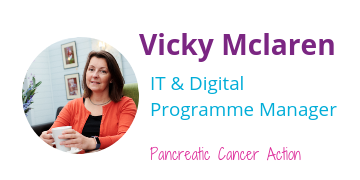Health Information. How has it changed over the last 21 years?
Our IT & Digital Program Manger, Vicky Mclaren looks at how health information has changed over the last 21 years.
Slowly. Until recently, that is.
The change has been largely an evolution. Alongside the emergence of patient centric care, patient information has evolved to focus on the patient, their family and care givers. Helped largely by organisations such as the Patient Information Forum and the NHS Information Standard, information that was once purely treatment focussed, is now strongly rooted in patient needs. It comes with practical and emotional guidance alongside treatment advice. It supports the patient through their whole journey. It is high quality, well reviewed and widely available.
Charities are patient advocates
Traditional publication via print is expensive, investment in capability development is expensive, so evolution has been by necessity, slow. Against the background of public spending austerity over the past 5 years, community and charitable organisations have contributed. They have developed impressive health information capabilities over the past 20 or so years and offer a wide range of information to patients. As patient advocates, they balance the perspectives of physician and patient, family and care givers and support the best outcomes for patients.
Social Attitude
Changes in social attitude have also evolved during this time. Patients are now more likely to want to find out about their disease for themselves whereas generations before would have looked solely to their doctors for information and advice.

As we approach the end of the 2010’s we have prospered from technological opportunities like never before.
Technological Opportunity
The rapid emergence of smart, mobile technologies has provided an exciting and very different landscape in which we deliver health information. It has never been cheaper, faster or easier to develop and distribute information to as wide or disparate an audience as it is now, at a time convenient and relevant to the patient. The emergence of rapid App development and wearable technology represent great opportunities to tailor information further and complement it with real time data for the patient and their physician to view.
A huge contrast to the landscape 20 years ago when a photocopied hospital leaflet was the most common information patients were given.
Accessibility
Let’s pause for a moment; there are some issues to consider; tech savvy, web connected patients can become overwhelmed by so much information available to them.

So, exciting and promising as the opportunities are, we still want to deliver information to patients in a way that truly informs each and every one of them. To do this we continue to follow the same fundamental principles we have for the past 20 years – to produce information that is accessible, reliable and meets patient needs.
